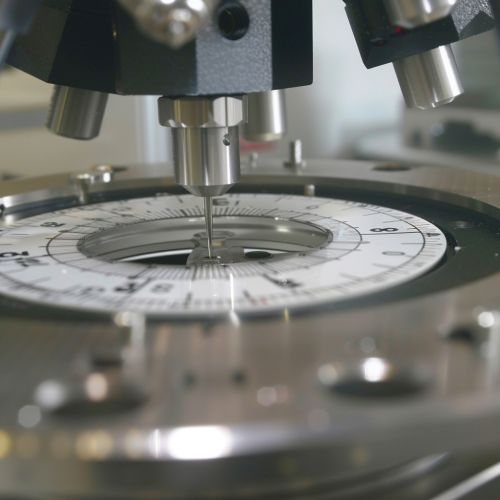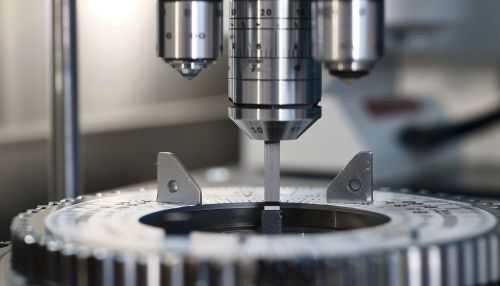Micrometre
Overview
A micrometre (also known as a micron, symbol: μm) is a unit of length in the metric system, equal to one millionth of a metre (0.000001 m). The micrometre is a standard unit of measurement in many scientific and engineering disciplines, including physics, biology, materials science, and engineering. It is particularly useful for measuring wavelengths of infrared radiation, sizes of biological cells and bacteria, and thicknesses of thin films and coatings.
History
The concept of the micrometre as a unit of measurement has its roots in the development of the metric system during the French Revolution. The term "micron" was officially adopted in 1879 by the International Committee for Weights and Measures (CIPM). However, the term "micrometre" is now preferred in scientific literature to avoid confusion with the older term "micron."
Applications
Physics
In physics, the micrometre is often used to measure wavelengths of infrared radiation, which range from about 0.7 to 300 micrometres. It is also used to describe the dimensions of microscopic particles, such as colloidal particles and aerosols. The micrometre is a crucial unit in the field of nanotechnology, where it serves as a bridge between the macroscopic and nanoscopic scales.
Biology
In biology, the micrometre is indispensable for measuring the sizes of cells, bacteria, and organelles. For example, a typical eukaryotic cell ranges from 10 to 100 micrometres in diameter, while a typical bacterium is about 1 to 10 micrometres long. The micrometre is also used in histology to measure the thickness of tissue sections.
Materials Science
In materials science, the micrometre is used to measure the thickness of thin films and coatings, which are often in the range of a few micrometres. It is also used to describe the grain size in metals and ceramics, which can significantly affect the material's properties. The micrometre is a key unit in metallography, where it is used to measure the dimensions of microstructural features.
Engineering
In engineering, the micrometre is used in precision machining and manufacturing processes. Tolerances in the range of micrometres are common in the production of high-precision components, such as those used in aerospace and electronics. The micrometre is also used in metrology to calibrate instruments and verify the accuracy of measurements.
Measurement Techniques
Optical Microscopy
One of the primary tools for measuring micrometre-scale objects is the optical microscope. Optical microscopy techniques, such as bright-field, phase-contrast, and fluorescence microscopy, allow scientists to visualize and measure objects as small as a few micrometres. Calibration of the microscope using a stage micrometer is essential for accurate measurements.
Scanning Electron Microscopy (SEM)
Scanning electron microscopy (SEM) provides higher resolution and greater depth of field than optical microscopy, making it suitable for measuring objects in the sub-micrometre range. SEM uses a focused beam of electrons to create detailed images of the sample surface, allowing for precise measurements of microstructural features.
Atomic Force Microscopy (AFM)
Atomic force microscopy (AFM) is another powerful technique for measuring micrometre-scale objects. AFM uses a sharp probe to scan the surface of a sample, providing topographical information with nanometre-scale resolution. This technique is particularly useful for measuring surface roughness and thickness of thin films.
Interferometry
Interferometry is a technique that uses the interference of light waves to measure distances with high precision. It is commonly used in metrology to measure the thickness of thin films and coatings, as well as the flatness and surface roughness of optical components. Interferometric techniques can achieve sub-micrometre accuracy.
Standards and Calibration
International System of Units (SI)
The micrometre is a derived unit in the International System of Units (SI), which is the modern form of the metric system. It is defined as one millionth of a metre, and its symbol is μm. The SI system provides a standardized framework for measurements, ensuring consistency and accuracy across different fields of science and engineering.
Calibration Standards
Calibration of instruments that measure micrometre-scale objects is essential for ensuring accuracy and reliability. Calibration standards, such as stage micrometers and calibration grids, are used to verify the performance of optical and electron microscopes. These standards are traceable to national and international metrology institutes, such as the National Institute of Standards and Technology (NIST) and the International Bureau of Weights and Measures (BIPM).
Future Trends
Advances in Microscopy
Advances in microscopy techniques, such as super-resolution microscopy and cryo-electron microscopy, are pushing the boundaries of what can be measured at the micrometre scale. These techniques are providing new insights into the structure and function of biological molecules and materials, with implications for fields ranging from molecular biology to materials engineering.
Nanotechnology
The field of nanotechnology is driving the development of new measurement techniques and standards for micrometre-scale objects. As researchers continue to explore the properties of materials at the nanoscale, the micrometre will remain a crucial unit of measurement. Innovations in nanofabrication and characterization are expected to lead to new applications in medicine, electronics, and energy.
Metrology
The field of metrology is continually evolving to meet the demands of precision measurement at the micrometre scale. Advances in interferometry, AFM, and other techniques are improving the accuracy and reliability of measurements. The development of new calibration standards and reference materials is also enhancing the traceability of measurements, ensuring that they are consistent with international standards.
See Also


